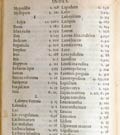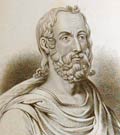Cabinet 02 - Pre-Linnaean Classification
 Classification is one of the oldest sciences. Aristotle (384-322 B.C.) divided organisms into two groups - plants and animals. Theophrastus, his pupil, divided plants, based on shape, into such broad categories as trees, shrubs, and herbs. Pedanios Dioscorides
(1st Century A.D.) was the father of medical botany. His fame rests on his De Materia Medica, in which more than 500 plants are named and described. For sixteen centuries it was considered the highest authority for medical and botanical students. This non-illustrated edition contains the Greek Dioscorides text alongside a translated Latin text by Jean Ruel, a French physician and botanist. The index tabulates plants such as irises, lilies, and mandragora (the mandrake, of the nightshade family (Solanaceae)).
Classification is one of the oldest sciences. Aristotle (384-322 B.C.) divided organisms into two groups - plants and animals. Theophrastus, his pupil, divided plants, based on shape, into such broad categories as trees, shrubs, and herbs. Pedanios Dioscorides
(1st Century A.D.) was the father of medical botany. His fame rests on his De Materia Medica, in which more than 500 plants are named and described. For sixteen centuries it was considered the highest authority for medical and botanical students. This non-illustrated edition contains the Greek Dioscorides text alongside a translated Latin text by Jean Ruel, a French physician and botanist. The index tabulates plants such as irises, lilies, and mandragora (the mandrake, of the nightshade family (Solanaceae)).
Dioscorides, Dioscoridis libri octo Graece et Latine. Castigationes in eosdem libros. Paris: Arnold Birkman, 1549. Shoults Fb 1549 D
 The Naturalist Library was the brain-child of William Home Lizars, a Edinburgh printer and engraver. He seconded Sir William Jardine
(1800-1874), the naturalist to undertake the editorial role. The series began in March 1833 and was divided into ornithology, mammalia, entomology and ichthyology. Each of the 40 volumes contained a lengthy memoir of a famous naturalist, and an engraved portrait as a frontispiece. Priced at a very reasonable six shillings, each volume also contained 30 to 40 hand-coloured plates printed from steel engravings. Here Pliny looks across at two colourful Ring Pigeons, engraved by James Stewart, an Edinburgh artist who was paid one guinea per drawing.
The Naturalist Library was the brain-child of William Home Lizars, a Edinburgh printer and engraver. He seconded Sir William Jardine
(1800-1874), the naturalist to undertake the editorial role. The series began in March 1833 and was divided into ornithology, mammalia, entomology and ichthyology. Each of the 40 volumes contained a lengthy memoir of a famous naturalist, and an engraved portrait as a frontispiece. Priced at a very reasonable six shillings, each volume also contained 30 to 40 hand-coloured plates printed from steel engravings. Here Pliny looks across at two colourful Ring Pigeons, engraved by James Stewart, an Edinburgh artist who was paid one guinea per drawing.
Prideaux John Selby, 'The Natural History of Pigeons.' Vol. V. pt. III. The Naturalist's Library. Edinburgh: W. H. Lizars, S. Highley, and W. Curry Jnr, 1835. DeB Sb 1833 N O5 pt.3
 Gaius Plinius Secundus, known as Pliny the Elder, was born in Como in 23 CE and died by inhaling the fumes from Mt Vesuvius in 79 CE. He was a contemporary of Dioscorides, although there is no evidence that they met. Pliny's best known work was his Historia Naturalis, an encyclopedic compilation of almost all knowledge, including myths, legends and superstitions, known at the time. In it, some 1000 different plants are mentioned, although given Pliny's lack of scientific training, his gullibility, and a strong reliance on earlier writers, there are obvious mistakes. Despite them, he did advance botanical knowledge. On display is a section on lilies, and the violet and marigold.
Gaius Plinius Secundus, known as Pliny the Elder, was born in Como in 23 CE and died by inhaling the fumes from Mt Vesuvius in 79 CE. He was a contemporary of Dioscorides, although there is no evidence that they met. Pliny's best known work was his Historia Naturalis, an encyclopedic compilation of almost all knowledge, including myths, legends and superstitions, known at the time. In it, some 1000 different plants are mentioned, although given Pliny's lack of scientific training, his gullibility, and a strong reliance on earlier writers, there are obvious mistakes. Despite them, he did advance botanical knowledge. On display is a section on lilies, and the violet and marigold.
